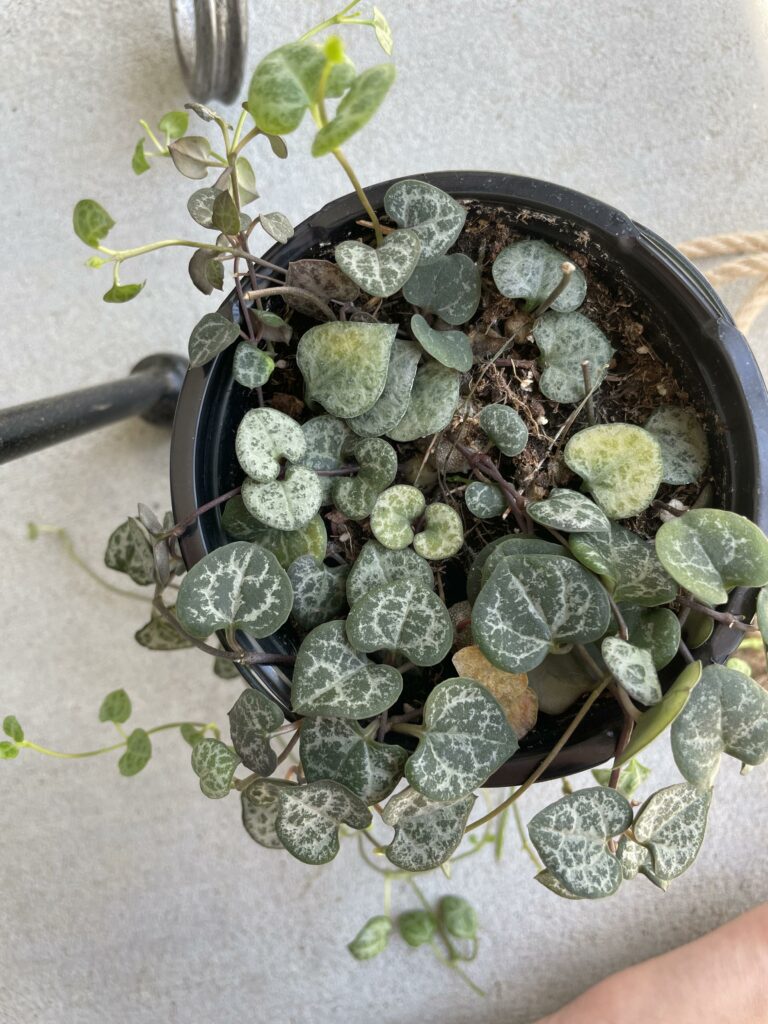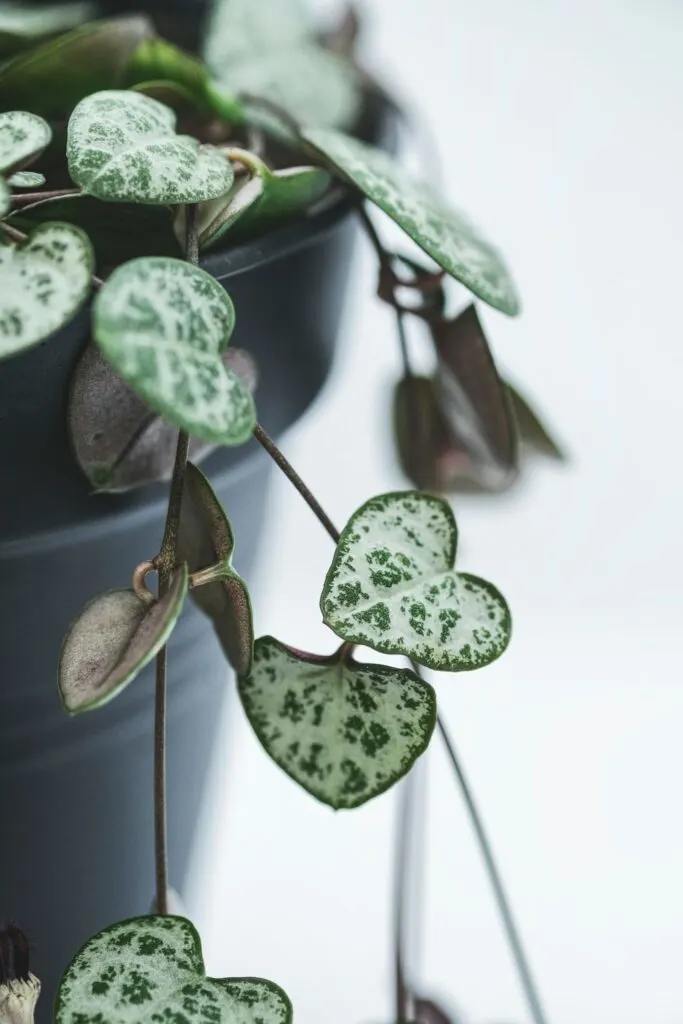Worried and wondering, why is my String of hearts turning yellow? We got you all covered!
The String of hearts, popularly known as the Rosary vine, is a common indoor succulent plant. The small, green heart-shaped leaves hanging off the long thin vines are pretty enough to make it win the game.
However, these thick hearts are pretty delicate and need proper care.
Just a slight negligence, and you will see your String of hearts getting prominently unhealthy. The most common problem with this plant is the yellowing of leaves.
Please keep reading to learn the possible reasons for the String of hearts turning yellow and their solutions to help your Rosary vines thrive!
Let’s begin!

Why Is My String of Hearts Turning Yellow?
We will share the common mistakes that can lead to the yellowing of leaves in your String of hearts.
The common reasons behind the yellowing of your Rosary vine are:
- Overwatering
- Poor drainage
- Low temperature
Let us have a detailed understanding of each of these below.
1. Overwatering
When it comes to yellow leaves in the String of hearts plant, the most common reason is overwatering.
Gone unchecked, it can lead to further issues like loss of leaves and root rot. To your surprise, it can also kill your plant.
How to Avoid Overwatering?
Well, don’t worry, as you can easily keep a check on this issue.
The key here is to follow the succulent watering method strictly. The water storage in the thick succulent leaves helps them bear short periods of drought.
Water the plant and wait for the upper few inches to get dry before the next watering.
How to Water My String of Hearts Plant?
This succulent plant hates to stay in wet or soggy soil.
You can easily kill a succulent by overwatering.
- So, don’t water it unless 2/3 of the soil is dry.
- Checking the soil will help you understand the plant’s water requirements and develop a watering schedule accordingly.
- The watering frequency also depends upon growing conditions like temperature and humidity.
- A plant placed in a warm and well-lit place may need to be watered often as compared to a plant in humid and cooler conditions.
- Similarly, the weather also affects the watering requirements of the plant. As a general guide, water your plant once or twice every seven to ten days in spring and summer.
- On the other hand, succulents usually get dormant in winter. This state of sleep minimizes their nutrient requirement.
- As a result, watering your plant once every month or two is absolutely enough to keep it alive.
That would be enough to prevent overwatering your String of hearts.
Related article: How to Fix Overwatered and Underwatered String of Hearts?
How to Check for Waterlogged Soil in String of Hearts Plant?
Wet or soggy soil leads to mushy and rotting roots in succulents.
The reason behind this is the inability of the soil to absorb any further nutrients. That will ultimately lead the plant foliage to turn yellow and fall, followed by drooping out of the plant.
Once you see your String of heart plant turning yellow, you first need to check if it is waterlogged.
Some of the signs which can help you study for it are mentioned below:
1. Smelly Soil
Mushy roots are going through a process of decomposition, which produces a foul smell. You can quickly check the plant by putting your face closer to the soil to see if it stinks or not.
2. Finger or Chopstick
This is another way to check the soil.
- Just stick your finger or a stick inside the soil for about two to three inches. If it comes out sticky, you can easily see the soil is over wet.
- On the other hand, the stick or finger coming out dry with just soil dust indicates you can water your plant.
Just make sure to be slow and gentle, as you don’t want to damage the roots. If you feel any larger roots coming your way, simply select another random spot of the soil.
3. Moisture Meter
You can simply buy a moisture meter.
This is a small and inexpensive gadget that helps budding growers to check the moisture level of the soil.
How to Fix a Waterlogged String of Hearts Plant?
Once you know your plant is suffering from wet soil, you must rescue it soon. Any further delay will increase the damage and even kill your plant.
You may think of letting the soil dry out naturally.
However, it will take good time, which can further deteriorate the plant’s health. So, that is not a good option at all!
The best solution to this issue is to take out and repot your plant in a fresh potting mixture.
1. Repotting
Here are some simple steps:
- Just loosen the soil around the plant base and take it out along with the roots.
- Just be as gentle as possible in order to avoid damaging the roots.
- Afterward, shake the roots lightly to remove the sticky soil.
- You can cut the badly damaged and mushy roots as they are useless to the plant.
- Now, plant it in a fresh potting mixture.
Make sure to set good quality and well-draining potting mix to help the plant grow healthy.
2. Pruning
The next step after repotting is to prune the yellow leaves.
They will never be healthy again and are only a burden on the plant.
So, it is better to get rid of them to help the plant use its energy for new growth.

2. Poor Drainage
The following possible reason for why is my String of hearts turning yellow is poor drainage.
Check for drainage if you are sure about using the proper watering schedule but the soil is still waterlogged.
How to Enhance Drainage for String of Hearts Plant?
Succulents need a well-drained soil/potting mixture and a pot with good drainage at the base.
1. Perlite
You can enhance the drainage of the growing mix by adding perlite to it. That will help the mixture to drain the water quickly without letting it stay.
2. Suitable Pot
Make sure the pot has drainage holes at the base—that will allow excess water to move down and let the soil dry out quickly.
3. Adding Stones
Ensure the drainage holes are working fine without any blockage, like small stones or fungus.
An expert practice is to put some stones at the pot’s base before filling the potting mixture. Just make sure you are not blocking the hole.
That will save these holes from getting blocked by debris or soil.
4. Terracotta or Clay Pots
Clay pots with drainage holes are the ideal pot choice for your String of heart succulent.
This natural material helps the evaporation of excess water from the sides. Consequently, the soil does not get soggy.
3. Cold Temperature
Last on our list of reasons why is my String of hearts turning yellow is the cold temperature.
This vine, like all other succulents, likes to stay warm. The ideal temperature for your plant ranges between 60–80°F.
They don’t flourish in cold temperatures; anything below 41°F can freeze and kill the plant.
How to Maintain a Suitable Temperature for the String of Hearts Plant?
Here’s what you can do.
1. Use a Thermometer
The easiest way to keep a suitable temperature is to use a thermometer.
Consider using a digital thermometer to check and manage the temperature around your plant.
Also, you can use it to figure out the temperature of different spots in your place at different times.
This will help you to select a suitable place for your plant.
2. Avoiding Cold Winds
The delicate plant must stay away from cold winds and drafts.
You may be keeping the plant in a warm room, neglecting the cold winds from the nearby windows disturbing it.
That will result in the quick yellowing of leaves followed by the leaf drop.
Thus, please ensure that the plant is not placed near cold windows and drafty areas.
3. Cut and Report
Using a suitable routine and giving proper care is a prudent approach to keeping a plant healthy.
Experts recommend keeping an eye on your plants’ health through weekly or bi-weekly checks. It is always better to catch any occurring issue at the earliest stages.
Have you followed the directions and all possible measures to help, but still, your String of hearts is not recovering from yellow leaves?
The last resort is to save the healthy parts of the plant.
Cut and replant them into the new pot and provide all the requirements.
Here’s how to propagate the String of hearts plant:
Conclusion
The String of hearts is a delicate climber, prone to the yellowing of leaves.
Why is my String of hearts turning yellow, you asked? The three reasons include overwatering, poor drainage, and low temperature.
Following right growing directions and providing particular requirements is the best way to keep a plant healthy. The next step is keeping an eye on the plant and giving regular checkups. That will help you to catch the yellowing of leaves and any other issues.
I hope this provides you with a quick rescue for your String of hearts plant.
Regards,
Happy planting!
